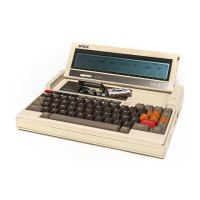software, and
on
the CP
1M
command line, it
is
the only way
to
delete a
character.
I
HOME
I:
The L!,!OME I key
as
the name suggests moves the cursor
to
the top
left hand corner
of
the virtual screen (not the window).
KEYS
~
TO I PF5 I : The Programmable Function keys
These are a set
of
keys which enable the user
to
enter a string
of
characters
which will be printed when the key
is
pressed. This
is
as
if
they had been typed
in by the user
at
the keyboard. The PX-8 is programmed with a default set
of
characters which allow the most common
CP
1M
commands to be input with
one keystroke. Also when BASIC
is
entered, a default set
is
available, which
corresponds to the common BASIC commands.
The strings are altered by means
of
the CONFIG program in
CP
1M, which
is
described in Chapter
3.
The BASIC Reference Manual describes how
to
alter
them in BASIC.
Pressing a programmable function key together with the
I
SHIFT
I key enters
a different user defined string. The names PF6
to
PFIO are given
to
the shifted
keys
I
PF1
I
to
I PF5 I , i.e. a value
of
5 is added
to
the number
of
the program-
mable function key
if
it
is
shifted.
Since there are ten function key strings
it
is
sometimes difficult
to
remember
which key has which string associated with it. The strings assigned
to
each func-
tion key can be displayed
on
the eighth line
of
the screen.
If
the eighth line
shows the following display:
dir
Idump
type
Isubmit
stat
Iddt
pip
Iterm~
config~/filink~
Fig.
2.12
This means function key lliIJ will print the characters
"dir"
when pressed,
and
"dump"
when pressed with the shift held down (i.e. the I PF6 I key
is
pressed)
and so
on
across the screen. The "
.J
"character
means that the equivalent
of
pressing the I
RETURN
I key
is
also added
to
the characters printed. A I
RETURN
I
is
not added with the characters
if
it
is
likely that other commands
or
parameters
2-16
need to be added.
The assignments can be changed using the CONFIG program described in Chap-
ter
3.
This also has
an
option
to
switch the display
of
these function key assign-
ments on and off.
Pressing a programmable function key (
LfITJ
to I PF4 I ) together with the
I CTRL I key calls a subroutine specified by the user.
If
no subroutine
is
speci-
fied, nothing happens.
Pressing the
I CTRL I and I PF5 I keys simultaneously outputs, the contents
of
the
display screen to the printer.
2-17

